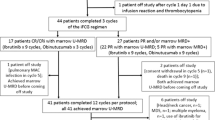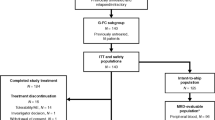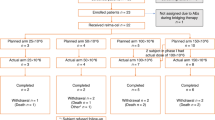Abstract
We examined the clinical response of fludarabine-refractory CLL patients treated with high-dose methylprednisolone (HDMP) and rituximab. Fourteen patients were treated with three cycles of rituximab (375 mg/m2 weekly for 4 weeks) in combination with HDMP (1 gm/m2 daily for 5 days). All patients were refractory to fludarabine and 86% had high-risk disease by the modified Rai classification. In all, 79% of the patients had CLL cells that expressed ZAP-70 and three patients had poor prognostic cytogenetics. The overall response rate was 93% and the complete remission rate was 36%. The median time-to-progression was 15 months and the median time-to-next treatment was 22 months. Median survival has not been reached after a median follow up of 40 months. Four patients have died of progressive disease. Patients tolerated the treatment well and serious adverse events were rare. This allowed patients to receive all planned treatments on schedule with no dose modifications. All but one patient responded to treatment and the overall survival and time-to-progression were superior to those of other published salvage regimens.
This is a preview of subscription content, access via your institution
Access options
Subscribe to this journal
Receive 12 print issues and online access
$259.00 per year
only $21.58 per issue
Buy this article
- Purchase on Springer Link
- Instant access to full article PDF
Prices may be subject to local taxes which are calculated during checkout


Similar content being viewed by others
References
Wierda W, O'Brien S, Wen S, Faderl S, Garcia-Manero G, Thomas D et al. Chemoimmunotherapy with fludarabine, cyclophosphamide, and rituximab for relapsed and refractory chronic lymphocytic leukemia. J Clin Oncol 2005; 23: 4070–4078.
Bosch F, Ferrer A, Lopez-Guillermo A, Gine E, Bellosillo B, Villamor N et al. Fludarabine, cyclophosphamide and mitoxantrone in the treatment of resistant or relapsed chronic lymphocytic leukaemia. Br J Haematol 2002; 119: 976–984.
Cheson BD . Monoclonal antibody therapy of chronic lymphocytic leukemia. Cancer Immunol Immunother 2006; 55: 188–196.
Keating MJ, Flinn I, Jain V, Binet JL, Hillmen P, Byrd J et al. Therapeutic role of alemtuzumab (Campath-1H) in patients who have failed fludarabine: results of a large International Study. Blood 2002; 99: 3554–3561.
Rai KR, Freter CE, Mercier RJ, Cooper MR, Mitchell BS, Stadtmauer EA et al. Alemtuzumab in previously treated chronic lymphocytic leukemia patients who also had received fludarabine. J Clin Oncol 2002; 20: 3891–3897.
Rai KR . Novel therapeutic strategies with alemtuzumab for chronic lymphocytic leukemia. Semin Oncol 2006; 33 (2 Suppl 5): S15–S22.
Byrd JC, Murphy T, Howard RS, Lucas MS, Goodrich A, Park K et al. Rituximab using a thrice weekly dosing schedule in B-cell chronic lymphocytic leukemia and small lymphocytic lymphoma demonstrates clinical activity and acceptable toxicity. J Clin Oncol 2001; 19: 2153–2164.
O'Brien SM, Kantarjian H, Thomas DA, Giles FJ, Freireich EJ, Cortes J et al. Rituximab dose-escalation trial in chronic lymphocytic leukemia. J Clin Oncol 2001; 19: 2165–2170.
Thornton PD, Hamblin M, Treleaven JG, Matutes E, Lakhani AK, Catovsky D . High dose methyl prednisolone in refractory chronic lymphocytic leukaemia. Leuk Lymphoma 1999; 34: 167–170.
Tsukada N, Burger JA, Zvaifler NJ, Kipps TJ . Distinctive features of ‘nurselike’ cells that differentiate in the context of chronic lymphocytic leukemia. Blood 2002; 99: 1030–1037.
Tsukada N, Kitada S, Reed JC, Kipps TJ . Combination rituximab and methylprednosolone mitigate the protective activity of nurse-like cells on leukemia cell viability in vitro. Blood 2001; 98: 3767a.
Cheson BD, Bennett JM, Grever M, Kay N, Keating MJ, O'Brien S et al. National Cancer Institute-sponsored Working Group guidelines for chronic lymphocytic leukemia: revised guidelines for diagnosis and treatment. Blood 1996; 87: 4990–4997.
Rassenti LZ, Huynh L, Toy TL, Chen L, Keating MJ, Gribben JG et al. ZAP-70 compared with immunoglobulin heavy-chain gene mutation status as a predictor of disease progression in chronic lymphocytic leukemia. N Engl J Med 2004; 351: 893–901.
Del Poeta G, Maurillo L, Venditti A, Buccisano F, Epiceno AM, Capelli G et al. Clinical significance of CD38 expression in chronic lymphocytic leukemia. Blood 2001; 98: 2633–2639.
Dohner H, Stilgenbauer S, Benner A, Leupolt E, Krober A, Bullinger L et al. Genomic aberrations and survival in chronic lymphocytic leukemia. N Engl J Med 2000; 343: 1910–1916.
Watson MS (ed). American College of Medical Genetics, Standards and Guidelines for Clinical Genetics Laboratories, edn. American College of Medical Genetics: Bethesda, MD 1999, pp 22–36.
Simon R . Optimal two-stage designs for phase II clinical trials. Control Clin Trials 1989; 10: 1–10.
Kaplan EL, Meier P . Nonparametric estimation from incomplete observations. J Am Stat Assoc 1958; 53: 457–481.
Peto R, Pike MC, Armitage P, Breslow NE, Cox DR, Howard SV et al. Design and analysis of randomized clinical trials requiring prolonged observation of each patient. II. analysis and examples. Br J Cancer 1977; 35: 1–39.
Kipps TJ . Chronic lymphocytic leukemia and related diseases. In: Beutler E, Lichtman MA, Coller BS, Kipps TJ, Seligsohn U (eds). Williams Hematology, 6th edn. McGraw-Hill, Inc.: New York, 2001, pp 1163–1194.
Seymour JF, Robertson LE, O'Brien S, Lerner S, Keating MJ . Survival of young patients with chronic lymphocytic leukemia failing fludarabine therapy: a basis for the use of myeloablative therapies. Leuk Lymphoma 1995; 18: 493–496.
O'Brien SM, Kantarjian HM, Cortes J, Beran M, Koller CA, Giles FJ et al. Results of the fludarabine and cyclophosphamide combination regimen in chronic lymphocytic leukemia. J Clin Oncol 2001; 19: 1414–1420.
O'Brien S, Kantarjian H, Beran M, Smith T, Koller C, Estey E et al. Results of fludarabine and prednisone therapy in 264 patients with chronic lymphocytic leukemia with multivariate analysis-derived prognostic model for response to treatment. Blood 1993; 82: 1695–1700.
Keating MJ, Kantarjian H, Talpaz M, Redman J, Koller C, Barlogie B et al. Fludarabine: a new agent with major activity against chronic lymphocytic leukemia. Blood 1989; 74: 19–25.
Hallek M, Schmitt B, Wilhelm M, Busch R, Krober A, Fostitsch HP et al. Fludarabine plus cyclophosphamide is an efficient treatment for advanced chronic lymphocytic leukaemia (CLL): results of a phase II study of the German CLL Study Group. Br J Haematol 2001; 114: 342–348.
Byrd JC, Peterson BL, Morrison VA, Park K, Jacobson R, Hoke E et al. Randomized phase 2 study of fludarabine with concurrent versus sequential treatment with rituximab in symptomatic, untreated patients with B-cell chronic lymphocytic leukemia: results from Cancer and Leukemia Group B 9712 (CALGB 9712). Blood 2003; 101: 6–14.
Thornton PD, Matutes E, Bosanquet AG, Lakhani AK, Grech H, Ropner JE et al. High dose methylprednisolone can induce remissions in CLL patients with p53 abnormalities. Ann Hematol 2003; 82: 759–765.
Ravandi F, O'Brien S . Immune defects in patients with chronic lymphocytic leukemia. Cancer Immunol Immunother 2006; 55: 197–209.
Acknowledgements
We thank Robier Aguillon and Oliver Loria for assistance with data collection. This work was supported in part by National Institutes of Health Grant PO1-CA081534 (TJK) and from the National Institutes of Health Grant K08-CA106 605-01 (JEC).
Author information
Authors and Affiliations
Corresponding author
Rights and permissions
About this article
Cite this article
Castro, J., Sandoval-Sus, J., Bole, J. et al. Rituximab in combination with high-dose methylprednisolone for the treatment of fludarabine refractory high-risk chronic lymphocytic leukemia. Leukemia 22, 2048–2053 (2008). https://doi.org/10.1038/leu.2008.214
Received:
Revised:
Accepted:
Published:
Issue Date:
DOI: https://doi.org/10.1038/leu.2008.214
Keywords
This article is cited by
-
Efficacy and safety of add-on anti-CD20 monoclonal antibody to Bruton tyrosine kinase inhibitor treatment for chronic lymphocytic leukemia: a meta-analysis
Scientific Reports (2023)
-
Harnessing cancer immunotherapy during the unexploited immediate perioperative period
Nature Reviews Clinical Oncology (2020)
-
Prognostic and therapeutic stratification in CLL: focus on 17p deletion and p53 mutation
Annals of Hematology (2018)
-
Chronic lymphocytic leukaemia
Nature Reviews Disease Primers (2017)
-
Efficacy of cisplatin-based immunochemotherapy plus alloSCT in high-risk chronic lymphocytic leukemia: final results of a prospective multicenter phase 2 HOVON study
Bone Marrow Transplantation (2016)



